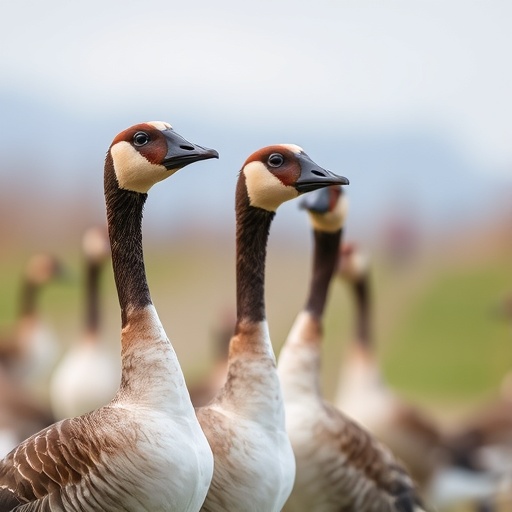A groundbreaking study from the Konrad Lorenz Research Center for Behavior and Cognition at the University of Vienna has unveiled critical insights into the social dynamics of animal groups, specifically focusing on how individual personality traits influence leadership and collective decision-making in greylag geese (Anser anser). This research, recently published in the journal iScience, challenges traditional assumptions about dominance and hierarchy by showing that boldness, rather than aggression, predicts leadership within animal groups. Notably, exploratory behaviors characterize those who choose to follow, revealing a complex interplay between individual temperaments and social roles that governs group movements in wild animal populations.
For decades, biologists have been fascinated by how groups of animals coordinate their activities—whether for foraging, migration, or predator evasion. While models based on simple interaction rules have successfully described collective movement patterns, the underlying personality-driven mechanisms behind social influence and leadership remained elusive. This new inquiry fills that gap by scrutinizing persistent individual differences through a comprehensive, longitudinal study of a marked flock living in Grünau im Almtal, Austria. This flock has been under observation since its introduction by the ethologist Konrad Lorenz in the 1970s, allowing researchers to measure consistent behavioral traits and their effects on daily collective choices.
The research team implemented an extensive observational protocol spanning four years, during which hundreds of group takeoffs were recorded. Each collective departure was analyzed for originator identity, follower response, and party composition. Coupling these data with personality assessments produced through standardized behavioral assays—flight initiation distance as an indicator of boldness, mirror test responses to gauge aggressiveness, and novel object interaction to measure exploratory curiosity—the study elucidates how these traits influence who leads and who follows in the wild.
A major revelation from the findings is that personality traits in greylag geese are remarkably stable over time and context. Individuals who repeatedly initiated group movement demonstrated higher boldness scores, asserting influence not through coercion or social dominance but via risk-tolerant behaviors that appear to inspire confidence among conspecifics. Intriguingly, aggressiveness did not statistically correlate with leadership, despite being linked to rank in other social contexts. This disconnect refines our understanding of the forms leadership can take in animal societies, emphasizing protective and risk-managing qualities over dominance and intimidation.
Followers predominantly exhibited high levels of exploratory behavior, suggesting an active role in selecting leaders who balance the demands of safety and resource discovery. This finding challenges the traditional notion that followers are passive recipients of collective decisions. Instead, the research highlights the cognitive ability of followers to evaluate leadership benefits and to preferentially follow bold yet nonaggressive leaders, who likely provide a sense of security when venturing into novel environments. This dynamic fosters innovation diffusion and adaptive information flow within the flock.
These behavioral insights resonate with the ecological necessity for geese to navigate daily trade-offs between familiar, safe habitats and potentially rewarding but unknown territories. Leaders’ boldness enables the flock to undertake riskier movements, while followers’ curiosity drives exploration and knowledge acquisition. Together, these complementary traits facilitate complex collective behaviors that maximize group survival and efficiency, embedding personality as a crucial axis of social and ecological adaptation.
From a broader perspective, the study invites a fundamental reassessment of leadership concepts across species. Rather than equating influence solely with aggression or dominance hierarchies, it points to nuanced social and cognitive mechanisms that underpin effective leadership and followership. This perspective elevates the importance of follower agency and decision-making, areas comparatively neglected in ethological and evolutionary research, and opens avenues for cross-taxonomic applications including human social dynamics.
The implications extend beyond theoretical biology to conservation and animal welfare, where understanding the individual variation influencing group behaviors can inform interventions, habitat management, and reintroduction strategies. Moreover, the research methodology itself, combining long-term field observation with rigorous behavioral phenotyping, sets a benchmark for future studies of collective animal behavior, seeking to decode the interplay between personality, social influence, and environmental challenges.
Critically, the work underscores that leadership is not a monolithic trait but a constellation of behavioral characteristics that interact with group composition and social context. Boldness acts as a catalyst for initiating movement, fostering safety and coordination, while exploratory tendencies in followers permit flexibility and adaptive responses to environmental uncertainty. Aggressiveness, though socially significant in rank establishment, appears insufficient to drive collective movement decisions, suggesting a decoupling of dominance and leadership functions within animal societies.
Lead author Sonia Kleindorfer emphasizes the transformative potential of this perspective: “Understanding which traits reliably predict influence shifts our focus onto the choices followers make, recognizing their cognitive engagement with leadership. This shift challenges centuries-old assumptions and invites reconsideration of influence dynamics in group living animals, including humans.” Such reframing holds promise for integrating personality psychology and social cognition into an enriched framework of collective animal behavior and cultural transmission.
Further research inspired by these findings may explore how information spreads through social networks shaped by personality constellations, how leadership styles vary across ecological contexts, and how such dynamics scale from small groups to large, complex societies. These efforts will deepen our grasp of the evolutionary pressures molding social roles and illuminate parallels with human leadership and cooperation.
For those captivated by these avian influencers and their dynamic flock, additional visual and contextual information is available through dedicated multimedia platforms, showcasing how personality shapes the elegant choreography of collective animal movement in real time.
Subject of Research: Personality traits influencing leadership and collective decision-making in greylag geese (Anser anser).
Article Title: Personality predicts collective behavior in greylag geese: influencers are bold and followers are exploratory.
News Publication Date: 15-Aug-2025
Web References:
https://www.youtube.com/watch?v=Xt2wEKDVbgI
http://dx.doi.org/10.1016/j.isci.2025.113170
Image Credits: Josef Hemetsberger, KLF
Keywords: Animal behavior, collective decision-making, leadership, personality traits, boldness, exploration, greylag geese, social influence, cognitive ecology, social learning, ethology, Konrad Lorenz Research Center




